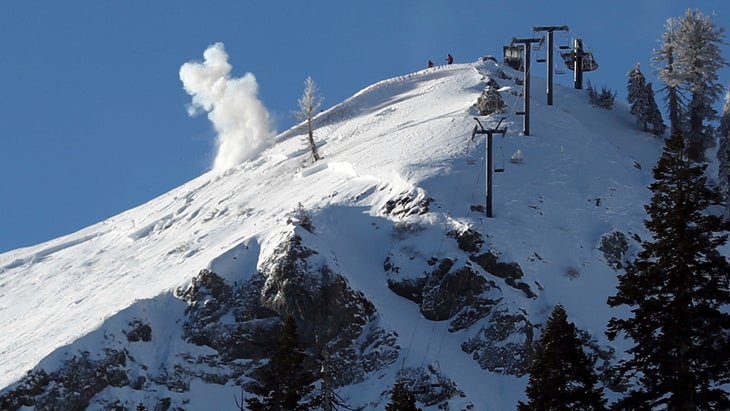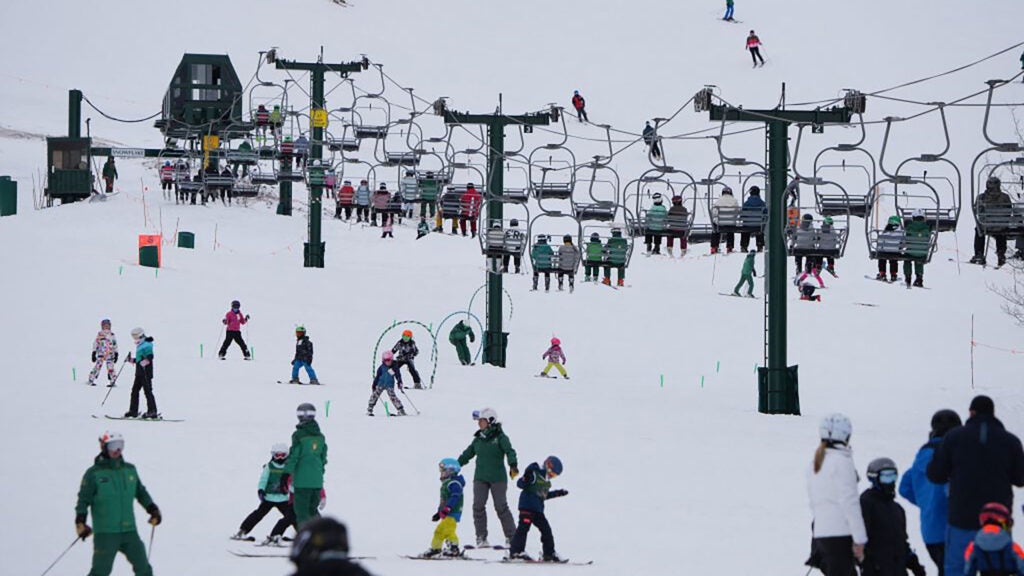No products in the cart.
Outdoor Adventure
Skiing Isn’t a Luxury Experience. It’s a Dangerous Sport.
On January 10, at Palisades Tahoe, an avalanche ripped down G.S. Bowl, a popular run right beneath the famed KT-22 chair, killing one person and trapping many others. As is almost always the case with inbounds avalanches, none of the skiers and snowboarders who were buried did anything wrong. And while investigations are ongoing, Palisades’ snow safety professionals—the patrollers that risk their lives in the predawn gloom tossing hand charges and ski cutting slopes to release avalanches before the public arrives—probably also did their jobs to the best of their abilities.
After a multiple-fatality slide at Silver Mountain, Idaho, in 2020, I gave some general advice about how to protect yourself inbounds. I also explained why inbounds avalanches happen in 2019 after a similar tragedy at Taos Ski Valley, in New Mexico. The unfortunate reality is that avalanche science is pretty good at assessing the likelihood of slides, but it cannot predict exactly where and when a slope will break loose. Nor will we ever know with total certainty that avalanche terrain—any ungroomed slope above 30 degrees, which includes pretty much everything above a blue square in the west—is 100 percent safe to ski. Mitigation doesn’t work that way. Resort snow safety teams live in a continuum where they can always be good, but they can never be perfect. In a 100 percent safe scenario, KT-22 would never spin.
The fatal slides at Palisades, Silver Mountain, and Taos highlight a disconnect in ski resort messaging that I’ve witnessed throughout my lifelong involvement with snow sports, including 25 years covering the subject as a journalist. Time and again, I see skiing marketed to the masses as approachable and welcoming, or as a luxury lifestyle choice for the wealthy. The truth, of course, is that skiing can be hazardous, and sometimes it can be deadly. But rarely have I ever seen resorts communicate the dangers of the sport to customers with the same vigor as they do plugging the fluffy accouterments. Ski resorts should start treating customers like adults, and stop pretending skiing and snowboarding are as safe as a fancy cruise—minus the hot tub norovirus.

There are reasons why approachability eclipses danger in resort messaging, of course. During my time covering the sport I’ve regularly seen executives promoted to the C-suite from marketing and guest services positions, but rarely have I seen ski patrollers rise to the same levels. Take a look at bios for executives at the two biggest resort companies in the world—Vail Resorts and Alterra Mountain Company—if you want proof.
Yes skiing can be family-friendly and luxurious, but it is also risky to varying degrees. That’s true of that blue run you just dragged your rookie boyfriend up without a lesson, and it’s also true of the steep avalanche terrain that you’re standing on top of waiting for the rope to drop. After a few flurries of inbounds avalanche fatalities in the past two decades, I believe most seasoned skiers and snowboarders understand the avalanche risk. Everyone else should read the lengthy online waiver that greets you before you buy your pass.
Except nobody reads waivers. I’ve addressed the need for skiers to be a bit more self-reliant in previous columns. But I think that marketing departments for ski resorts also need to do a better job of acknowledging and even—egads—addressing the risks: collisions on overcrowded slopes; long falls on iced-over runs; tree well suffocation; and yes, inbounds avalanches. Scan headlines from local newspapers over the past few months you will see examples of all of these dangers at North American resorts. Communicating the dangers of skiing in an adequate way will require a cultural shift at many resorts. That’s because the business model is about attracting the highest volume of customers and resorts don’t want to scare anyone off.
Resort skiing has always been a volume play. Lift lines in the seventies were routinely an hour long. They used to sell hot dogs and beer as you waited, and you had time for a second beer. Today, the lines move faster, but the resort conglomerates carry on that volume-first tradition by selling cheap season passes. I’ve argued in the past that those products are good because they can help bring new users, and maybe someday, diverse users, into skiing and snowboarding, which otherwise would have gone into a steady decline. But high volume comes at the cost of the experience and the safety of the guests. Ask any patroller at a resort where you feel as though you’re dodging other humans like bamboo gates why most accidents happen, and off the record he or she will say, “It’s the crowding.”
Again, I’m not calling out any specific ski resort here, certainly not Palisades, which, besides a misguided notion to rebrand one of the steepest ski areas in North America as a family ski hill about a decade ago has a well-earned extreme vibe and, last I heard, one of the best snow safety teams in the business. (I was complicit in that softer marketing. I produced their marketing magazine, which was full of low angle skiing and snot-nosed kids and by edict from above none of the steep skiing the mountain is famous for.) What I’m calling out is this: Resorts can feel free to market the posh, entitled, lifestyle that they love so much in these days of massive income inequality, but they also need to message that skiing comes with challenges and struggle and self reliance and, yes, risk. Even mellow resort skiing requires as much dedication to skills training and fitness as mountain biking and surfing. Backcountry skiing comes with the gravitas of whitewater, big wave surfing, and alpinism. Skiing on avalanche terrain—no matter if it’s inbounds or out—should take years of skills development to get to that level. Skiing and snowboarding are epic because the sports beat you down. Mountains are iconic because they’re unforgiving.
Some resorts already get that. They tend to be the ones that market themselves as ski “areas” not ski “resorts.” Arapahoe Basin in Colorado, which was just purchased by Alterra, and cut skier volume a few years ago to preserve the experience, is one. I hope that management style will continue. Fernie, which is avalanche-challenged by slopes above the resort, is another. Alta, Utah, the birthplace of snow science and avalanche mitigation in the U.S., is a third. When the Alta sheriff tells you to move your car because it will get buried overnight, you tend to pay attention. In Europe, everyone knows that if you ski off-trail you are in the backcountry and you could die.
The corresponding spatial awareness, mountain sense, and self reliance you see at burlier ski areas can and should be encouraged everywhere. When Bridger Bowl, Montana, first opened the short and steep Ridge zones that runs above the lower ski area, they required skiers to carry avalanche beacons—the rest of the avy gear is advised. They carried on that tradition when they opened the steep Slushman’s zone in the 2000s. There’s a similar deal at Delirium Dive in Canada’s Sunshine Village. There’s only one way to access that legit extreme terrain, and you need gear and a partner to do it. Crystal Mountain, Washington, has a related, if grayer, policy for its Southback zone which they mitigate for avalanches but recommend skiing with avy gear and a partner at the access gates.
My favorite ski area in North America is Silverton Mountain in Colorado. The year Jenny and Aaron Brill opened Silverton, I skied and reported a story there for Powder magazine. The wider industry and avalanche community was predicting doom for the enterprise because every inch of Silverton Mountain is avalanche terrain in one of the most slide-prone parts of the world. The Brills sold Silverton recently, but the ski area they founded succeeded through endless mitigation, a guided-only policy in mid-winter, and a no-bullshit attitude that emphasized showing respect to the mountain. At Silverton, the guides will ridicule you rather than let you get cavalier. This is both hilarious and necessary. When it comes to unguided skiing and snowboarding, Silverton customers treat the terrain like backcountry. At Silverton, you feel a little nervous twinge before you ski. We shouldn’t turn that switch off at fancier resorts just because they have marble counters in the shitters.
It will likely never happen because of legal concerns and greed, but in my worldview, many North American ski areas should require avy gear and partners in certain zones. The requirement brings a lot of benefits. For one, it can reduce the stigma or perceived stigma of carrying safety gear inbounds. In Utah recently during a big storm cycle, I watched a few locals snicker at some vacationers skiing with packs inbounds. Yeah, one skier had a shovel strapped to a hydration pack and didn’t have high style points, but his mindset was correct. When gear is required for certain zones, more guests will be wearing beacons in transmit mode. That’s an easy win. And second, like the strenuous hike up Aspen Highlands’ eponymous bowl, gear helps to filter skiers. Meaning, the people that probably shouldn’t be skiing your gnarliest terrain might think better of it.
The timing is right for this cultural shift. Backcountry skiing and snowboarding are no longer niche pursuits. There are enough skiers with gear and training to change how avalanche terrain is managed. Hell, while requiring gear won’t bring your ski area more cash, it will bring more cachet. You can market adventure again instead of pots of molten cheese and those hot stones they put on your back at the spa.
But the bigger benefit in nudging this cultural shift forward is that in carrying gear and trusting in a partner, skiers also learn to trust themselves. If we as skiers and snowboarders do that, then maybe the insanity of an inbounds powder day can move subtly in the direction of smarter skiing, with customers having conversations about the hazards, buddying up, poking around cautiously at times, and looking out for one another. That last bit might be wishful thinking. But even if all ski areas do is require safety gear and partners in certain zones, at the least we’d be a lot faster on the rescues.
Source link

